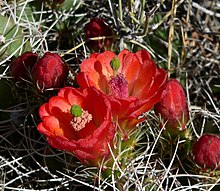| Echinocereus | |
|---|---|

| |
| Echinocereus triglochidiatus | |
| Scientific classification | |
| Kingdom: | Plantae |
| Clade: | Tracheophytes |
| Clade: | Angiosperms |
| Clade: | Eudicots |
| Order: | Caryophyllales |
| Family: | Cactaceae |
| Subfamily: | Cactoideae |
| Tribe: | Echinocereeae |
| Genus: | Echinocereus Engelm.[1] |
| Type species | |
| Echinocereus viridiflorus | |
| Species | |
|
See text | |
| Synonyms[1] | |
Echinocereus is a genus of ribbed, usually small to medium-sized, cylindrical shaped cacti, comprising about 70 species native to the southern United States and Mexico in very sunny, rocky places. Usually the flowers are large and the fruit edible.
The name comes from the Ancient Greek ἐχῖνος (echinos), meaning "sea urchin", and the Latin cereus meaning "candle". They are sometimes known as hedgehog cacti,[2] a term also used for the Pediocactus and Echinopsis.[3]
- ^ a b "Genus: Echinocereus Engelm". Germplasm Resources Information Network. United States Department of Agriculture. 2004-02-13. Archived from the original on 2012-10-11. Retrieved 2011-04-10.
- ^ "Echinocereus". Integrated Taxonomic Information System. Retrieved 2011-04-10.
- ^ "Echinopsis (Hedgehog Cacti)". Cactus and Succulent Society of Australia. Archived from the original on 2008-07-20. Retrieved 2008-07-29.